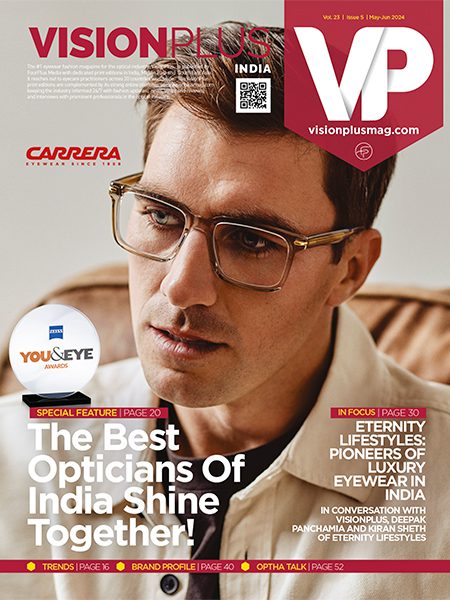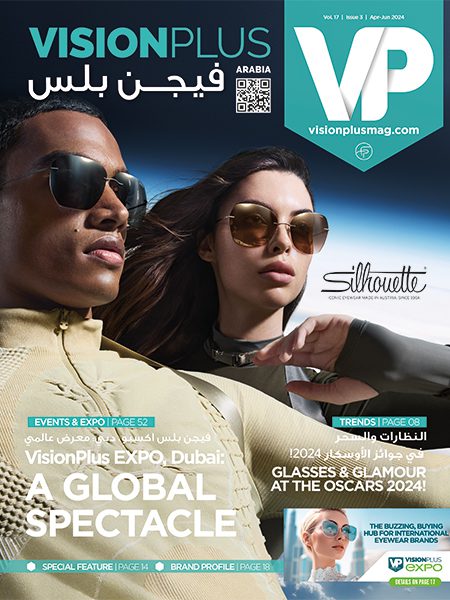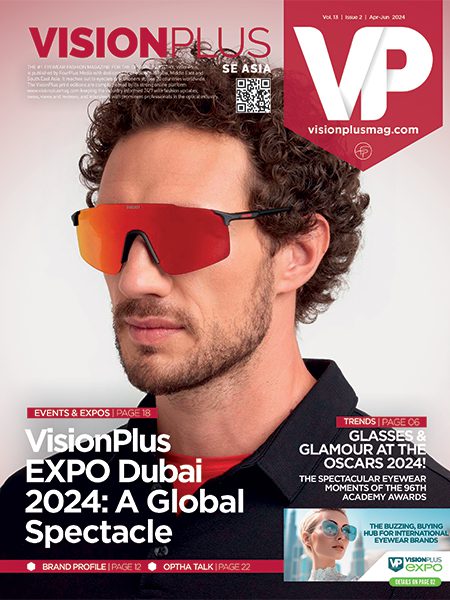The globally acclaimed and appreciated brand NOVA from the house of Vision Rx Lab joins the movement of providing a comfortable, uninterrupted natural vision experience to Presbyopes…
NOVA IRIS sports completely customised and personalised PAL designs that best suit the visual requirement of the wearer, based on the position of the spectacles, their lifestyle requirements and visual behaviour. Every eyewear model in their portfolio comes with a volley of Surface Optics Optimizing technologies through Digital Freeform manufacturing process – styled as Digi-Contour Technology.
Here is a look at some technical aspects of the optimisation patterns that make Nova Iris an extremely innovative option in its category.
Intelligent Lens view design:
For over a century the Ostwalt curve of the Tscherning ellipse has been followed to select the ideal Base Curve to produce thinner and flatter lenses with optimal optical performance
But the problem arises when there is a significant difference in the distance power and the near power.
For Example, consider the following prescription:
Distance Rx : +2.00 Ds Near Add: +2.00Ds.
According to Vogel’s formula, the ideal Base curve for the Distance power in the prescription is
Base Curve = +2.00 + (+6.00) = +8.00 D.
But for near power the requisite base curve is
Base Curve = +4.00 + (+6.00) = +10.00 D
In standard 100%, back surface optimized Digital Freeform PALs since a single vision semi-finished lens is used where the front curve remains unaltered, it is usually not possible to meet the appropriate Base Curve requirements of all the power profiles since the semi-finished lens has a single curve in its front surface.
Nova Iris, however, employs a DUAL SURFACE OPTIMIZATION through INTELLIGENT LENS VIEW DESIGN, wherein the front curve changes progressively from flatter to steeper to provide the exact/closest possible Base Curves required for all the different powers from distance to near vision to provide Maximal visual field, Optimal Magnification with almost no appreciable distortions through the visual areas in maximal usage in distance, intermediate as well as near zones, while optimising the design parameters & incorporating Aberration filters in the rear surface.
The appropriate base curves for all power profiles provide a definite advantage over the so-called cosmetically appealing ‘FLAT BASE CURVE’ lenses, where the prescription deviates drastically as the points drift away from the optical centre, rendering visual blur & distortions due to improper retinal focus through the para-centric regions of each visual zone.
Vogel’s formula for Plus lenses: Base Curve = Spherical Rx + 6.00 D
Vogel’s formula for Minus Lens: Base Curve = Spherical Rx/2 + 6.00 D
In case of cylindrical or compound prescriptions, the spherical equivalent is used in the place of spherical Rx
Intelligent Lens View Design
Aberration Filter System 2.0:
The behaviour of the lens near its optical centre, within an area, referred to as the paraxial region is given by the focal power formula:
P = F + B (where P refers to the Power in Diopters, F & B the power of the front curve & the power of the rear curve respectively)
But a lot of considerations needs to be done to allow the wearer a clear & almost distortion-free view through the peripheral regions of a PAL.
Aberration Filter System 2.0 not only takes into account the spherical & astigmatic aberrations, but also the induced higher order aberrations, power error, distortions etc. & corrects them to a great extent.
Some considerations out of many include a deeper understanding of the sagittal & tangential errors & the induced oblique astigmatism.
Astigmatic Error induced is calculated as a difference in the dioptric values between the sagittal & tangential values at numerous points on the lens & addressed according to the scope.
As the eye rotates vertically and horizontally behind the lens, the far-point moves with the eye at a fixed distance from its centre of rotation (C). This movement describes an imaginary spherical surface, known as the far-point sphere. In the absence of oblique astigmatism, a spectacle lens brings light to a focus across a curved image plane referred to as the Petzval surface. The curvature of the field is an aberration that results from the difference in focus between a flat focal plane and the curved collection of actual focal points on the Petzval surface. Unfortunately, the Petzval surface is generally flatter than the far-point sphere. Power error is an aberration that results from the difference in focus between the Petzval surface (PS) and the far-point sphere (FPS) of the eye. The aberrations are thus calculated & corrected as per the maximum possibility.
The spherical aberrations & Sway & distortions are further minimized by incorporation of Multi-Aspheric correction in the rear surface & induction of Horizontal Atoricity.
Retina Forward Design:
A simulation of the lens is prepared in front of the eye & information about the PAL design selected for the wearer is considered to determine which areas of the lens are meant for distance, intermediate or near vision. The optimization that simulates all different gaze directions is repeated thousands of times until the back surface yields the desired power in each direction of sight so as to focus each emergent pencil of light on the retina – despite the variation of distance to near corneal vertex distance for all gaze directions through the selected frame. Very Small Incision (VSI) Technology with a 3D diamond cutting tool 0.90 is employed for maximal accuracy.
State-of-the-art Customization:
The PAL design for Nova Iris is planned with a complete analysis of the ‘visual lifestyle’ of the wearer, understanding the weight & visual priority for tasks within the daily routine. The position of wear measurements like Pantoscopic tilt, Face Form Wrap, Corneal Vertex Distance, Frame measurements, Monocular Naso-pupillary distance, Segment Depth, Near Working Distance, Old PAL Design & Prescription Data are some of the parameters that are used to create the best possible design. Binocular Balance of visual fields, individual monocular Near Insets, variable fitting heights are some additional features which make Nova Iris a unique PAL.
The journey of Vision Rx Lab with the global brand NOVA continues to lead the way with better management of refractive conditions as their research and development process remains dedicated for providing innovative as well as advanced optical solutions for consumers, in line with their motive- VISION meets FASHION.











